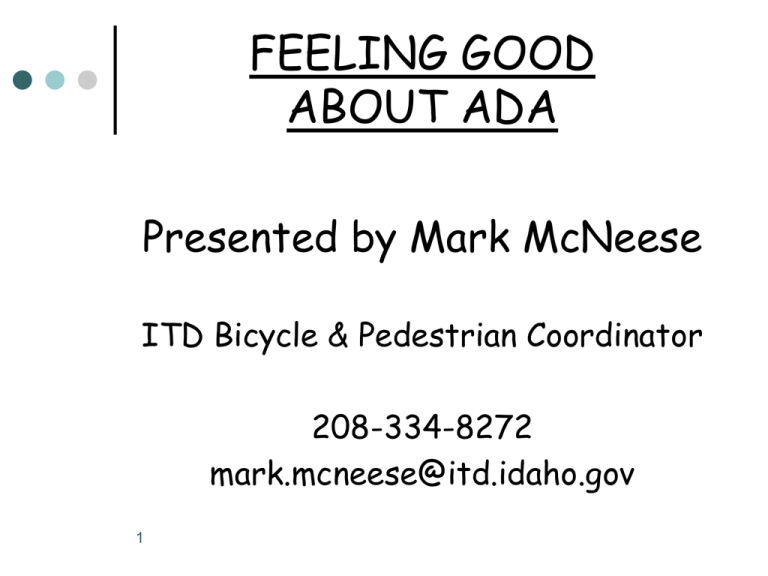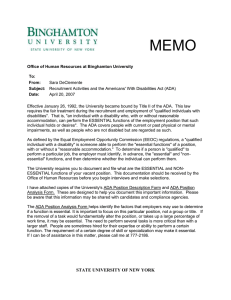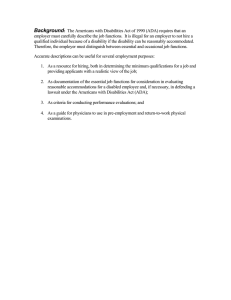Feeling Good about ADA.ppt
advertisement

FEELING GOOD ABOUT ADA Presented by Mark McNeese ITD Bicycle & Pedestrian Coordinator 208-334-8272 mark.mcneese@itd.idaho.gov 1 PEDESTRIAN DEFINED 28-101(40) NV CODE …means any person afoot and any person operating a wheelchair or a motorized wheelchair or an electric personal assistive mobility device. 2 WHAT DO WE FOLLOW? We are currently operating under the Americans with Disabilities Act (ADA) of 1990. The ADA built upon previously existing law dating back to the Civil Rights Act of 1964 and the Architectural Barriers Act (ABA) of 1968. 3 WHAT DOES THE ADA COVER? 4 Title I applies to employment discrimination, public or private. Title II applies to the programs, services, and activities of a “public entity.” Title III applies to “public accommodations.” WHAT DOES ADA COVER? 5 Title VI addresses telephone and television access for people with hearing and speech disabilities. Title V covers miscellaneous provisions. WHICH TITLES APPLY TO TRANSPORTATION? 6 Title II requires that state and local governments give people with disabilities an equal opportunity to benefit from all of their programs, services, and activities. Title III requires newly constructed or altered places of public accommodation to comply with the ADA standards. USING THE RIGHT WORDS… Person with a disability People with disabilities Disabled Impaired Handicapped 7 USING THE RIGHT WORDS… Impairment refers to the performance of an organ or part of the body. Handicap is a disadvantage due to an impairment or disability that limits or prevents a person from fulfilling a normal role. Disability refers to the performance of an activity by a person. 8 DEFINE “PERSON WITH A DISABILITY” … 9 an individual with a physical or mental impairment that causes a substantial limitation of the individual's ability to engage in one or more major life activities. WHAT ARE LIFE’S MAJOR ACTIVITIES? Include, but are not limited to, caring for one's self, performing manual tasks, walking, seeing, hearing, speaking, breathing, learning, and working. 10 DEFINITIONS DIFFER AMONG PROGRAMS… Yes they do, but the Supreme Court in 1999 narrowed the definition of who is a person with a disability. See… http://www.accessiblesociety.org/topics/ ada/williams2.htm 11 HOW IS THE ADA ENFORCED? The U.S. DOJ is responsible for issuing regulations to implement Titles II and III, except to the extent that transportation providers subject to Titles II and III are regulated through the U.S. DOT. 12 A citizen may enforce the ADA Titles II & III through civil litigation in a U.S. District Court. ADA can pay the plaintiff’s legal fees and costs if they are not awarded. WHO IS PROTECTED BY THE ADA? A person with a disability, having a history of a disabling impairment, or being regarded as having a disabling impairment. The ADA does not specifically name all of the impairments that are covered. 13 THE SHIFT IN OUR AGING POPULATION… In the U.S… 1900 — avg. life expectancy was 47 2001 — avg. life expectancy was 77 1900 — 3.1 million over 65 2001 — 35 million over 65 14 A BIGGER SHARE… By 2030 in the U.S. 20% of the population will be 65+ A BIGGER “BIGGER” SHARE… The number of obese adults over the age of 60 in the United States is expected to reach nearly 21 million in 2010, a 43percent jump from 2000. 2006 Newsweek Inc. online 16 POOR NUTRITION AND INADEQUATE PHYSICAL ACTIVITY = An obesity epidemic… Currently impacting over 30% of U.S. adults and approx. 20% of children. Resulting in… 17 Increased medical problems, some eventually leading to decreased mobility. U.S. CENSUS 2000… What percent of the U.S. population has a “disability?” 20% [one in five] 18 Facilities are Critical to Senior Mobility The desire to maintain mobility and freedom doesn't diminish with age. More than one-third of the disabled elderly need special assistance and equipment to travel. 19 WHO ARE WE DESIGNING FOR? PBIC IMAGE LIBRARY by M CYNECKI 20 WHO ARE WE DESIGNING FOR? Walker users need… Sidewalks that are flat and smooth (no rough, uneven surfaces) Curb ramps Extra time to cross intersections Space for others to pass as they are slower and less mobile 21 WHO ARE WE DESIGNING FOR? PBIC IMAGE LIBRARY by ITE BIKE/PED COUNCIL 22 WHO ARE WE DESIGNING FOR? Division of Public Transportation 23 WHO ARE WE DESIGNING FOR? Wheelchair users need… Sidewalks that are flat and smooth (no rough, uneven surfaces) Curb ramps Extra time to cross intersections Space for others to pass as their “footprint” is static Properly equipped transit vehicles 24 WHO ARE WE DESIGNING FOR? PBIC IMAGE LIBRARY BY DAN BURDEN 25 MOBILITY SCOOTERS… Designed to carry… Oxygen tank Walker Cane or Crutch Cargo Manufacturers’ ads stress “retaining mobility and freedom” to their potential customers. 26 PERSONS WITH TEMPORARY DISABILITIES 27 Those who use crutches and wheelchairs due to surgery, breaking a limb, etc.have a newly found appreciation for… Elevators Automatic doors Curb cuts Sidewalks WHO ARE WE DESIGNING FOR? PBIC IMAGE LIBRARY by M. KING 28 WHO ARE WE DESIGNING FOR? Photo by Mark McNeese 29 WHO ARE WE DESIGNING FOR? Photo by Mark McNeese 30 WHO ARE WE DESIGNING FOR? Visually Impaired Vision when corrected 20/70 to <20/200 Legally Blind Vision when corrected 20/200 or greater (= 1.5% of ID pop. or approx. 20,000 people) 31 WHO ARE WE DESIGNING FOR? Photo by Mark McNeese 32 WHO ARE WE DESIGNING FOR? Over 10 million visually impaired in U.S. There are approx. 1.5 million legally blind, expected to rise to 2.3 million by 2015. Vision impairment is more common in older people. 33 At age 65 one in nine are legally blind. At age 85 one in four are legally blind. WHO ARE WE DESIGNING FOR? The legally blind Orientation — understanding where you are and what is around you. Mobility — the ability to travel safely and as independently as possible from one place to another. 34 MOBILITY TECHNIQUES… 35 Residual vision and the other senses White cane Guide dog Sighted guide WHAT CAN WE DO? “How well different individuals can overcome their barriers, depends not only on the impairment and on the abilities of the individual, but also on the society and the environment in which the individual operates.” A. Colenbrander, MD 36 DURING CONSTRUCTION… An alternative route, with accessible features, must be provided Temporary roadway signage should not block pedestrian facilities 37 OTHER FEATURES… Amenities for pedestrians must be accessible Drinking fountains Pay phones Signal-actuating buttons Kiosks 38 THE GOOD, BAD AND UGLY… Good = Done recently and done right! Bad = Been like this a long time and is a detriment to accessibility. Ugly = Done recently and done wrong! 39 THE GOOD, BAD AND UGLY… 40 “IMPLIED” SIGNAGE … CAUTION SIDEWALK ENDS USE ROADWAY 41 “IMPLIED” SIGNAGE … CAUTION NO SIDEWALK PLEASE WATCH FOR WHEELCHAIRS ON ROADWAY!!! 42 THE GOOD, BAD AND UGLY… 43 THE GOOD, BAD AND UGLY… 44 THE GOOD, BAD AND UGLY… 45 THE GOOD, BAD AND UGLY… 46 THE GOOD, BAD AND UGLY… 47 THE GOOD, BAD AND UGLY… 48 THE GOOD, BAD AND UGLY… 49 THE GOOD, BAD AND UGLY… 50 THE GOOD, BAD AND UGLY… 51 THE GOOD, BAD AND UGLY… 52 THE GOOD, BAD AND UGLY… 53 THE GOOD, BAD AND UGLY… 54 THE GOOD, BAD AND UGLY… 55 THE GOOD, BAD AND UGLY… 56 THE GOOD, BAD AND UGLY… 57 THE GOOD, BAD AND UGLY… 58 THE GOOD, BAD AND UGLY… 59 THE GOOD, BAD AND UGLY… 60 THE GOOD, BAD AND UGLY… 61 ACCESSIBILITY CHECKLISTS… Are they needed? Sidewalk Attributes Curb Ramp Attributes Crosswalk Attributes Pedestrian light Attributes 62 RESOURCES… www.access-board.gov http://www.accessboard.gov/prowac/index.htm (revised draft guidelines for accessibility in public right-of-way 11/23/05) Followed by a NPRM Followed by a Final Rule 63 NEW ADA STANDARDS… Will amend 28 CFR 35: Nondiscrimination on the basis of disability in state and local government services. Will amend 28 CFR 36: Nondiscrimination on the basis of disability by public accommodations and in commercial facilities. 64 IN CLOSING, SOME MYTHS AND FACTS… Myth — The courts are flooded with ADA lawsuits. Fact — Only 650 in the last 5 years. The primary goal of the U.S. DOJ's enforcement program is to increase voluntary compliance through technical assistance and negotiation. 65 IN CLOSING, SOME MYTHS AND FACTS… Myth — The ADA is rigid and requires fast, sizable expenditures to make existing facilities accessible. Fact — Only when they are “readily achievable” and or can be done “without much difficulty or expense.” 66 IN CLOSING, SOME MYTHS AND FACTS… Myth — The ADA requires all government buildings to be accessible. Fact — The ADA requires all government programs, services, and activities to be accessible. 67 IN CLOSING, SOME MYTHS AND FACTS… Myth — The subject is far-removed from me. Let the “experts” worry about these kind of improvements. Fact — Look around the room. This is who we are planning, designing, and constructing for. Please be conscientious so we have a transportation system that works for all of us, now and in the future. 68 THANK YOU!!! Questions or Comments??? 69



